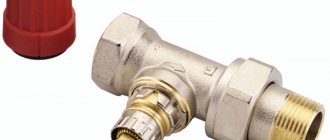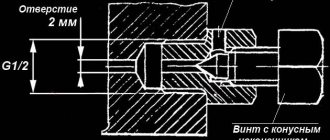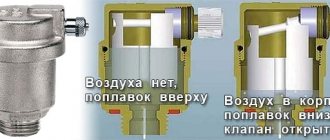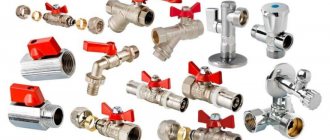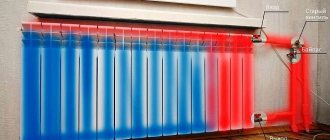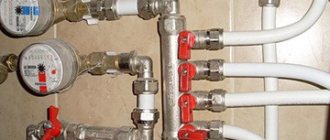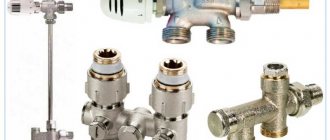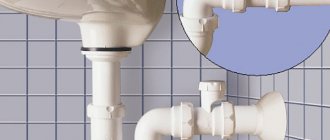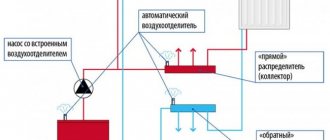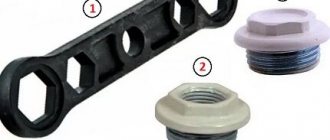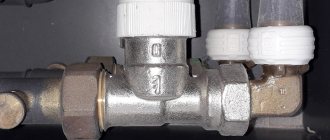The Mayevsky faucet is a plumbing device that serves to bleed air from heating radiators; in other words, the Mayevsky faucet is needed to bleed the air accumulated in the battery.
The Mayevsky tap is opened with a special key or a flat-head screwdriver.
How does air appear in the radiator?
When the coolant circulates, a certain amount of air contained in it enters the system. Air can form bubbles, especially in areas of low pressure and low fluid velocity.
These bubbles create air pockets that prevent the free circulation of coolant in the system. Air can also appear when the heating system is idle.
Therefore, air must be periodically removed through an exhaust device, which is the Mayevsky tap.
The tap is installed at the top point of the system or radiator.
Why do you need a Mayevsky valve?
An air lock prevents the coolant from moving along the circuit and entering remote parts of the batteries, which leads to a decrease in heating efficiency, increased pressure in the pipes and malfunctions of the heating system.
The gradual release of air from hot water circulating through the radiators is a natural and inevitable process. The rate of formation of air jams increases for the following reasons:
- air entered the system during installation, repair or replacement of individual sections;
- during purging and subsequent filling of the system during seasonal maintenance, the coolant was supplied with insufficient pressure;
- the tightness of the pipe joints is broken and air leaks occur;
- Corrosive processes occur - oxidation of the material of pipes and radiators, which releases oxygen.
If you find a blockage, you can call a plumber who will release the accumulated air. If the system is prone to airing, then calls from specialists will have to be paid regularly. This problem can be solved simply and effectively, and most importantly cheaply, by installing a Mayevsky valve in places where air locks form.
Automatic air vent
Nowadays, the desire to replace people with automation has led to the creation of automatic air vents. Without the intervention of a plumber, air leaves the system as it enters. By the way, they are also called Mayevsky automatic cranes.
The principle of operation is clearly visible in the figure: if there is air in the system, it freely passes past the float, through the spool, which is opened by spring pressure. Then the air escapes through the nozzle into the atmosphere. If there is no air in the heating battery, then the water raises the float, which, using a lever (not shown in the figure), presses on the holder. The spring compresses, the spool closes the nozzle.
For an apartment I recommend the Mayevsky mechanical crane. It's more reliable. Automation may fail if the water in the heating system contains various impurities. The spool valve will become clogged with dirt, and it will begin to leak water. There won't be a catastrophic flood.
Automatic air vent
What is a Mayevsky crane?
Attempts to solve the problem of air locks in heating systems were made at the beginning of the 20th century. For this purpose, taps were actively used - they coped with the task of bleeding air, but they were often used not only for their intended purpose, but also to drain water from the heating circuit for other purposes.
Uncontrolled coolant discharge caused damage to the heating network, as it could cause the formation of additional air pockets and changes in pressure in the pipes. In addition, due to the high temperature of the water entering the radiators, the people using it could also be harmed.
Inventor Ch.B. Mayevsky, after whom the air vent is named, did not come up with the valve itself for venting air, but a method for sealing its parts. Mayevsky proposed connecting the parts of the crane cone to cone. This made it possible to maintain the tightness of the heating network unit in the closed position. In addition, this design made it inconvenient to draw water from the heating device.
We recommend that you read: How to remove a severe clog in the toilet yourself?
Design and principle of operation
The Mayevsky tap is made from corrosion-resistant materials such as brass. The outside of the metal case may have a plastic shell to give a more aesthetic appearance.
The main parts of the Mayevsky crane design:
- housing with inlet calibration and outlet drain holes,
- cone needle valve,
- sealing ring,
- valve or locking screw with a socket head or screwdriver.
The design of the air vent can be changed and supplemented with other elements, have different thread diameters, while the principle of operation remains the same.
In the closed position, the needle valve maintains the tightness of the system and does not allow coolant to leak out. When you turn the locking screw, the needle moves, freeing the drain hole.
Air flows from the battery into the calibration hole of the valve and is released out through the drain hole. After the air is released, the resulting cavity is filled with hot water, coolant circulation is restored, and the pressure inside the pipes is equalized.
Carrying out repair work
If you discover signs of air in the heating system, you should not immediately start getting rid of it. First, check the circuit for integrity and tightness. After all, if there are leaks, problems will continue.
Coolant leak
Coolant leakage is the loss of fluid that occurs due to loose connections and damage to the circuit.
Photo 1. Leak in the heating system pipe. Such a problem can cause poor operation of the heating structure.
Possible leak locations and solutions:
- Pipe sections. To stop the leak, clamps and cold welding are used. If the pipe is plastic, the entire section is replaced.
- The joints between parts of the system are sealed. Welding is used.
- Loose connection of radiator sections. You will have to remove the battery and tighten the connections (on aluminum). Cast iron radiators are glued with a cloth containing epoxy resin.
This is a labor-intensive part of the work of preparing the system for the heating season. But this must be done, otherwise you may be left without heat in winter.
A constant loss of coolant will lead to unstable operation of the system.
Features of the underfloor heating system
The presence of a heated floor complicates the system; it is not easy to remove air from the floor loops.
Air plugs appear due to:
- reducing pressure;
- strong heating of the coolant;
- leak formation;
- violation of the tightness of connections;
- errors made during installation (uneven surface, pipe slope, errors in the organization of the collector);
- illiterate first launch of the system.
In order for the system to start correctly, the air is bled from it before the boiler is turned on and the coolant is heated.
If a warm floor is the main means of obtaining a comfortable temperature, then air should not be allowed into it.
Attention! A conventional system works even if there is air there. The efficiency will decrease , but heat will still flow. When air appears in the circuit, the floor will stop heating - the reason for this is the complex installation and small diameter of the pipeline.
Removing air from the floor circuit is a lengthy process:
- Only one circuit on the collector is turned on
- The pressure is built up above the working pressure ( by 15-20% ).
- The circulation pump starts at low speed. It takes some time to fill the circuit so that the coolant displaces the air. Then the next circuit is activated, so one by one all the branches passing through the collector are slowly filled.
- The process lasts several days. This is repeated until all the air is released.
- This is done with cold coolant ; heating is turned on only when it is certain that the air has completely escaped.
Reference. When installing the system, it is useful to think about equipping the floor circuit with a separator - a device for automatically removing air from the pipes.
Coolant renewal frequency
Liquid is an important component of heating that must be used correctly.
Periodic replacement is necessary, but should not be overused. The optimal shelf life of liquid in pipes is 12 months, subject to mandatory draining of the system.
Synthetic coolants: propylene glycol, ethylene glycol remain in the system for up to 7-8 years.
Photo 2. Canister with synthetic coolant for the heating system. This substance lasts longer than ordinary water.
The concentration of synthetic compounds in the liquid extends the shelf life of the coolant. But if there is no need to use antifreeze , then you can get by with plain water.
The replacement time will be determined by coarse filters: if they do not need to be washed and replaced, then the water in the system is also suitable and does not need to be changed.
This is important because each fresh portion of liquid is a fresh set of salts and impurities, oxygen, which reacts with new forces with internal surfaces, settling on them in layers that gradually reduce the efficiency of the system.
Important! The water that is already in the circuit is a prepared liquid , without impurities and active substances. The fact that the water has changed color does not change its value - it has already undergone reactions, become inert and is now an optimal addition to the efficiency of the system.
Types of Mayevsky cranes
There are three types of Mayevsky crane:
- Manual. The air vent is the simplest and most reliable configuration; the outlet of the needle valve is located directly in the nut housing. May be equipped with a nylon cap that contains a seal to allow air to pass through. Operated manually using a four- or hex key, screwdriver or built-in screw.
- Auto. Does not require manual control, but if necessary, cleaning the tap is possible. In Mayevsky's automatic tap, a plastic float is installed inside the brass body. When an air lock forms, the water level in the structure decreases, the float drops and unblocks the outlet. As air is released, the float rises, closing the valve. This type of air vent was developed specifically for installation in hard-to-reach areas of the heating circuit; it is suitable for houses and apartments with individual heating. Not suitable for cast iron radiators and central heating, as it will often become clogged.
- Faucet with safety lock. It also works automatically, but does not react to air accumulation, but regulates the pressure in the thermal circuit. The design, supplemented by a sensor, when the coolant pressure is above 15 atmospheres, opens the valve and begins to bleed water, reducing the pressure to normal. Such a valve allows you to prevent disruptions in the operation of individual sections of the heating network and prevent its breakdown in the event of a water hammer. But air is released through a valve with a safety lock manually.
Varieties
There are three types of air vents, differing in operating principle and design:
1. Mayevsky manual tap . This is the simplest device that is controlled manually. If uneven heating of the radiator is detected, the tap can be opened with a key or any screwdriver, and then, as air leaves the radiator, turn the tap in the opposite direction.
The photo shows a Mayevsky manual type crane
2. Automatic tap . The difference between an automatic crane is the absence of manual control of its operation. Its design and operating principle are somewhat different from the functioning of a manual crane. An automatic faucet is made of brass in the form of a cylinder, but there is no needle valve in its design. Instead, a plastic float is used. How does an automatically controlled Mayevsky crane work? A plastic float, depending on the presence of air in the system, moves inside the tap and controls the opening and closing of the valve. Everything happens without human intervention.
The principle of operation of the Mayevsky automatic crane is visually demonstrated in the photo above.
All automatic taps have the ability to be manually controlled, which can be used when the passage opening becomes clogged.
3. Crane with built-in safety device . For this type of Mayevsky crane, the principle of its operation is somewhat different from the usual bleeding of air. The safety valve is able to control the coolant pressure in the system. If the coolant pressure exceeds the limit value, reaching 15 atmospheres, the valve will operate and begin to forcibly bleed the coolant from the heating system. This prevents damage to individual elements of the system in the event of sudden water hammer.
It is especially important to install air vents with safety valves in heating systems made of polypropylene and metal-plastic pipes, which may not withstand high pressure.
What to look for when choosing a faucet
The choice of an air vent depends on the heating system in which it will be installed, the material of the pipes and radiators, free access to the installation site and other nuances of installation and further operation.
- In houses with centralized heating, it is better to use a Mayevsky manual tap or a tap with a fuse, since water hammers occur in such heating networks. Automatic is best used in a private house with an individual heating system. In an apartment building with central heating, the automatic tap will become clogged due to contamination of the coolant.
- If cast iron batteries are installed in the room, it is better to equip them with a hand tap. For heating circuits made of metal-plastic or polypropylene pipes, a faucet with a built-in fuse is suitable, since they may not withstand water hammer.
- In hard-to-reach places: niches, recesses, install an automatic faucet or a manual one, equipped with a built-in valve.
- In rooms where children may be, on the contrary, it is not worth installing a faucet with an easy-to-open valve.
- The diameter of the external thread of the faucet must be selected in accordance with the diameter of the hole in which it will be installed. There are only three types for this parameter: 1, 0.5 and 0.25 inches; the same sizes of tap holes are provided in standard radiators.
- When purchasing a Mayevsky valve, it is important to pay attention to the material from which it is made. The design with a brass body will last the longest, as this material is resistant to corrosion.
- Seal on tap
We recommend that you read: What is needed for the air valve to work properly
Advantages and disadvantages
The device in question has a fairly large number of different advantages and disadvantages that must be taken into account. The obvious advantages are the following:
- The device can quickly remove air from the system.
- Manual versions can be installed in a wide variety of systems.
- Automatic taps are practically indispensable in individual systems. Air is bled almost immediately after the problem occurs.
It is worth considering that the only but significant drawback is the tendency to clog. If a large number of different substances are found in the coolant, then it is necessary to periodically clean the faucet from contaminants.
How to install a Mayevsky crane
Installation of the Mayevsky crane is quite simple and does not require special skills.
Procedure:
- Drain the system. If the heating network is equipped with a pump, turn it off 15 minutes before starting work.
- Unscrew the plugs in the places where the valves will be installed. Usually this is the top point of the radiator, farthest from the heating device; it is in such places that air most often accumulates.
- Screw in the Mayevsky tap so that the outlet is directed away from the wall at 45 degrees downwards - for easy collection of water when opening the valve. To ensure a tight seal, it is recommended to wrap the threads with oiled tow or FUM tape.
Installation features in certain situations
The easiest way to install a Mayevsky tap is in modern radiators, where all the necessary holes are provided.
When installing the tap on different types of pipes and types of heating circuits, you need to consider the following:
- In a vertical thermal circuit, the device is mounted in radiators on the top floor and on devices connected to the riser below the heating axis.
- In a horizontal heating system, taps are placed on all devices where this is structurally possible.
- In a floor radiator, the highest point is selected for installation, and the tap is placed with the screw facing up.
- In a heated towel rail with a bottom connection, the place for installing a tap is provided by the manufacturer. A tee is first cut into a heated towel rail with a side connection, and an air vent is installed into it. It is better to equip a heated towel rail with a complex shape with several valves.
- Cast iron batteries may not have a suitable hole; preparatory work will have to be done. You need to cut a hole in the plug slightly smaller than the size of the tap thread, cut the thread and then screw in the valve, further insulating the mounting location.
Note! To simplify working with a cast iron battery, it is better to completely disconnect it and select an air vent with a minimum external thread diameter.
Features of inclusion in the heating system
There are some peculiarities in the installation of air vent valves when they are screwed into the body of existing radiator plugs. Radiator plugs are usually screwed into the left-hand thread.
The faucet twists to the right, and therefore the plumber needs to fix the plug with one key and at the same time tighten the air vent with the second. But these are technical details that it wouldn’t hurt for inexperienced people to know about.
The installation diagram for air exhaust devices also has some features. So, if the radiator system is built according to a vertical arrangement of devices, air vent valves are usually placed on the heating radiators of the highest level.
But in a parallel connection scheme, even with a vertical structure, Mayevsky taps are installed in heating devices of the lower and upper levels. In general, in plumbing practice, installation in each individual case is done taking into account the possible accumulation of air in the system.
If the heating system is installed according to a horizontal scheme, then, as a rule, each heating device is equipped with air vents. By and large, it is advisable to equip almost any heating system equipment with air vent valves.
In reality the following equipment should be equipped:
- all heating batteries in the system;
- compensators, bypasses and similar devices;
- recorders and coils;
- pipelines of the upper level of the heating system.
Some circuit solutions even provide for the placement of a Mayevsky tap on heated towel rails. By the way, there are models of heated towel rails on sale whose designs have an entry point for the Mayevsky tap.
Operating rules for the Mayevsky crane
For smooth operation, even a simple mechanism requires the correct maintenance:
- If the exhaust channel becomes dirty, it must be cleaned using a needle or strong thin wire.
- When air is released along with oxygen, flammable gases may be released from the valve. Therefore, close proximity is unacceptable
- If air does not stop coming out of the drain hole for a long time, it is worth checking the thermal circuit for leaks. To do this, you need to take a thin sheet of paper and move it near the joints of the system. In places where air is leaking, the sheet will be attracted to the battery.
- The faucet valve stops turning due to metal corrosion if it is rarely used. To fix this, just treat it with WD-40 lubricant. To prevent such a situation, after the end of the heating season, the valve threads can be treated with silicone grease.
- Replacing the Mayevsky tap must be done using an auxiliary adjustable wrench to fix the radiator cap so as not to accidentally twist it. Otherwise, the battery may be damaged.
We recommend that you read: Using an American connection in plumbing
How to use the valve
Bleeding air when a plug is detected is carried out as follows:
- An empty container is placed under the battery at the location of the tap. You may also need a dry cloth.
- The locking screw is turned counterclockwise 90-180 degrees. After this, air will begin to escape from the battery with a characteristic hissing sound.
- When water flows from the tap, after its pressure has stabilized, tighten the screw in the opposite direction. The uniform flow of water means that there is no air left in the pipes that interferes with the normal circulation of the coolant.
Attention! If the air pockets are removed, but the batteries do not warm up completely, this means they are clogged. In this case, you should not do anything yourself; it is better to call a plumber.
